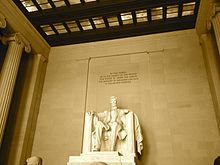Lincoln Memorial
| Lincoln Memorial | |
|---|---|
| National Register of Historic Places | |
| National Memorial | |
|
The Lincoln Memorial |
|
| location |
West Potomac Park , Washington, DC |
| Coordinates | 38 ° 53 '21.5 " N , 77 ° 3' 0.4" W |
| surface | 2,540 m² |
| Built | 1912-1922 |
| architect |
Henry Bacon (architect) Daniel Chester French (sculptor) |
| Architectural style | Greek Revival |
| Number of visitors | 3,639,000 (2005) |
| NRHP number | 66000030 |
| The NRHP added | October 15, 1966 |
The Lincoln Memorial is a memorial built between 1915 and 1922 in honor of Abraham Lincoln , the 16th President of the United States , on the National Mall in Washington, DC The design was by Henry Bacon .
Building
The 36 Doric columns of the Greek-style monument symbolize the 36 states that formed the United States during Lincoln's tenure. Later the names of the other 12 US states were carved around the roof of the monument, again later two plaques in the ground followed for the new states of Hawaii and Alaska .
The building is to up to 20 m deep concrete foundations established , which through the soft bottom of the former Marsh at Potomac were required. Lincoln's second inaugural address from 1865 is carved in stone on the north side, and the famous Gettysburg speech on the south side . There is also a five-foot tall statue of the seated Lincoln. The statue made of white marble is the work of the sculptor Daniel Chester French and is composed of 28 individual parts. The statue depicts Lincoln sitting on a chair, each of his hands on a fascis , a symbol of state violence. The figure was originally supposed to be made of bronze and 3 m high, but then Chester saw that the bronze statue was much too small for the large temple. So he built a statue that was almost twice as high and that was made up of 28 blocks of white marble.
The following text can be read on the wall above the head of the statue:
IN THIS TEMPLE
AS IN THE HEARTS OF THE PEOPLE
FOR WHOM HE SAVED THE UNION
THE MEMORY OF ABRAHAM LINCOLN
IS ENSHRINED FOREVER
( German : "In this temple, as in the hearts of the people for whom he saved the Union, the memory of Abraham Lincoln is forever held")
The memorial on the US currency
The $ 5 bill has Lincoln's portrait on the front and the Lincoln Memorial on the back. Between 1959 and 2008, the Lincoln Memorial was also depicted on the reverse of the US 1 cent coin .
Others
On August 28, 1963, a march of over 250,000 people moved from the Washington Monument to the Lincoln Memorial (see March on Washington for Work and Freedom ). There Martin Luther King gave a speech that became famous as I have a dream . The theme of the speech - equal rights for African Americans as for white US citizens - fits the place of the speech: Lincoln was an opponent of slavery. After he was elected US President at the end of 1860 , initially seven and later another four of the slave-holding southern states left the Union and founded their own confederation, the Confederate States of America . Lincoln led the remaining northern states into the Civil War . He successfully carried out the abolition of slavery in the USA and enforced the restoration of the Union.
In the second sentence of the speech, King alludes to Lincoln.
literature
- The Lincoln Memorial in Washington . In: Zentralblatt der Bauverwaltung , vol. 41 (1921) No. 30, pp. 186–187.
Web links
- National Park Service: Lincoln Memorial (official site; English)
- National Park Service: Lincoln Memorial Interactive (English, Flash required)
Individual evidence
- ↑ The description of the building is based on: National Register of Historic Places: Nommination Form - Lincoln Memorial ( Memento of the original dated February 24, 2012 in the Internet Archive ) Info: The archive link was inserted automatically and has not yet been checked. Please check the original and archive link according to the instructions and then remove this notice. , February 1981
- ↑ Five score years ago, a great American, in whose symbolic shadow we stand today, signed the Emancipation Proclamation. ( Full text )







